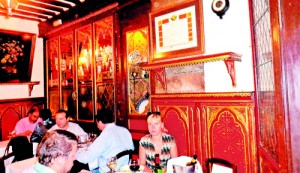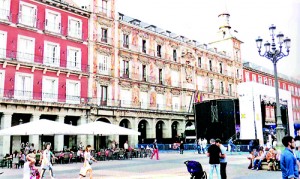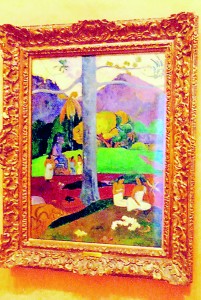Madrid: My favourite things
Spain has always been on my wish list of countries to visit and it became a reality last summer. My friend and I flew into the capital, Madrid, (with a population of nearly 4 million), which is in the centre of the country.

Founded in 1725: Madrid’s famous Botin Restaurant
One of the European countries suffering from a huge unemployment problem with inflation running at 25%, tourism seems to drive the Spanish economy during the summer months but the collapse of the construction industry has resulted in massive unemployment. We met a taxi driver in Barcelona, who was a US qualified architect and had been unable to secure work for five years after returning from the States. A number of North Africans who are illegal immigrants sell wares on the street and flee when the police approach the tourist sights on a tip-off.
Space constraints notwithstanding, here are some of the country’s fascinating attractions.
Madrid
The origins of Madrid are unknown and how the name came to be is also a mystery. There is speculation that the word may be from an Arabic word meaning “great bridge”. It was primarily a small agricultural settlement. The Arabs conquered the city in the 9th century and thereafter it was restored to Christianity in 1080 by Alphonse VI of Castile. In 1561 King Philip II (who built the Escoril) changed the city and Madrid became the capital and the expansion began. There was a period thereafter when the Bourbons took over followed by the Hapsburgs. The city has some imposing buildings, former palaces of the nobility and parks.
My American friend and I stayed at a small high-tech hotel five minutes from Plaza Mayor, a 16th century rectangular square. The square is now dotted with cafes where formerly, bull fights, executions, pageants and trials were conducted. There are allegorical paintings on the façade of one side of the square and the equestrian statue of the founder of the square Felipe II is at the centre. Eight minutes from our hotel was Puerta del Sol, a bustling half moon shaped square which converges on the shopping district and is a  popular meeting point. Look out for the emblem of the city, a bronze bear standing on his hind legs to eat the berries from a strawberry tree. The square is also known for the significance of past events, such as uprisings against the French forces, an assassination of a liberal Prime Minister and the proclaiming of a republic. On New Year’s night crowds gather in the square to herald in the New Year by eating grapes as the clock chimes twelve.
popular meeting point. Look out for the emblem of the city, a bronze bear standing on his hind legs to eat the berries from a strawberry tree. The square is also known for the significance of past events, such as uprisings against the French forces, an assassination of a liberal Prime Minister and the proclaiming of a republic. On New Year’s night crowds gather in the square to herald in the New Year by eating grapes as the clock chimes twelve.
We chose to wander towards the two hot spots and get our bearings for the next day and our ride on the hop on and off bus. The business district has large architecturally majestic buildings, floral roundabouts with marble statues and fountains; a column commemorating the gifting of the Americas by Christopher Columbus to Queen Isabella, the Duke of Alba’s mansion, the Wellington Hotel where the Matadors reside, the Real Madrid Stadium and Zara, a Spanish popular high-street fashion store are some of the sights that we drove past.
Our first choice was the Prado Museum flanked by a statue of Goya at the entrance. Charles III was determined to create a museum as a treat for art lovers and we spent time absorbing masterpieces by Goya, El Greco, Velazquez and Murillo. Special favourites of mine

Paul Gauguin’s Mata Mua at the Museo Thyssen Bornemisza
were the twin concepts by Goya in Room 36 of the same young lady painted as the Naked Maja and the Clothed Maja (tackling the subject of nudity for which the artist was accused of being obscene); Velazquez’s Las Meninas with its intricate dress detail of the young royal members with the artist included and El Greco’s haunting portrait of a Knight and his religious paintings which he specialized in and devoted his life to. The Three Graces representing love, joy and revelry which was one of Rubens last paintings is also on exhibition. Other floors contained Rubens, Ribera, Rembrandt and an early portrait of a younger Mona Lisa by a pupil of Leonardo da Vinci with a different backdrop. The Prado houses 7,000 paintings, 1,000 of which are on display or loaned to other collections. Other floors also house paintings by Gainsborough, and Reynolds amongst other renowned painters.
Across the street is the famous Hotel Ritz which the guide book described as Spain’s most extravagant with 158 rooms all decorated opulently, each in a different style. The carpets, chandeliers and the myriad flower arrangements were exquisite.
Madrid is renowned for its art galleries and we chose to spend most of our time at the galleries including the Museo Thyssen Bornemisza where we saw the private art collection of the family acquired by the Spanish State in 1993. The collection contains old Masters, the Renaissance period, Baroque art, the Dutch Masters and a section on modern American artists. Among the masterpieces were Gauguin’s paintings on Mata Mau, Van Gogh’s pastoral scenes, Canaletto’s well known views of Venice, Degas Ballerinas, The Harlequin with a Mirror by Picasso and other famed pieces.
The National Centre of Art Reina Sofia, a more modern art museum housed in a converted hospital exhibits the painting “Guernica” by Pablo Picasso (inspired by the attack on the Basque village during the Civil War by German pilots). The painting was brought back to Spain when democracy was restored, which was the artist’s wish. The “Woman in Blue” from his blue period was also on display.Another haunting exhibit was “The Accident” painted by Alfonso Ponce de Leon which he completed before his death.
The Royal Palace is not to be missed. This is mainly used on ceremonial occasions and it is best to go early in the day before large queues form. The changing of the guard takes place at certain times on specified days. The palace is exquisite having been decorated by King Carlos the III and IV. The present King has chosen to live in a smaller palace on the outskirts of Madrid. The Gasparini Room with its lavish Rocco chinoiserie, painted ceiling and ornate chandelier, the Chinese Room with its collection of Ming, the Porcelain Room with its porcelain in green and white depicting cherubs and the dining room laid out for State banquets are grand. The Pharmacy has a collection of unique pottery storage jars, recipe books detailing medications to be used by the Royal family.
On the recommendation of my niece, we dined one night at the fabled Botin Restaurant founded in 1725 and one of the first restaurants in the world according to the Guinness Book of Records. In the street called “Cuchilleros” where there were many workshops an inn was begun for travellers. An oven was built for roasting and traditional food served. Recommended are the suckling pig and roast lamb and cheesecake. Sangria red wine with fruit served in pitchers was our choice of drink throughout our trip.
We chose to spend a day in Toledo, a multi-cultural city, an hour’s drive from the city. The city was a meeting place for different races and faiths formerly and retains its history well. As we drove into the city the tourist bus paused for us to see the panoramic view from across the river. Entrance into the city is through nine gates and fortified by the old walls. The Romans first built a fortress on the hill, the Moors then occupied the city and the Christians thereafter followed by the Jews. Toledo was a cosmopolitan city for a number of years and at the end of the XVth century the Jews were expelled. Toledo’s ascendant as a capital declined with the shifting of the capital to Madrid by Philip II in 1561.
We walked through the narrow streets to see the Cathedral which was stunning with its different altar pieces, wooden choir stalls, marble and stone carvings. The central entrance known as the Pardon door is opened only on special occasions.
Walking through the narrow streets of the town I gazed into a sweet shop with model nuns amidst delicious cakes and sweets to tempt the passerby. Some stones depicted the menorah and religious symbols of the Arabs.
One of the city’s most famed inhabitants was El Greco who was born in Crete in 1541 but lived in the city after training with Titian in Italy. He thereafter stayed and painted most of his masterpieces commissioned by the King here. We saw his paintings of Christ and the twelve apostles (he chose various people for their faces as apostles including prisoners) and his famous work the Funeral of the Count de Orgaz. The artist has painted himself in the background. Toledo is worth the effort of getting to and not to be missed for its unique history.
The next day early in the morning we boarded the Renfe train from the Madrid Station and travelled to Seville.
(Next week: Seville)


